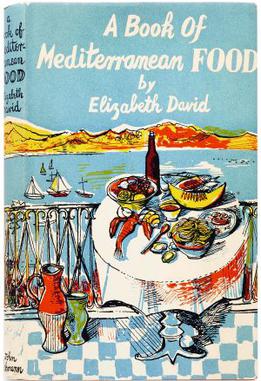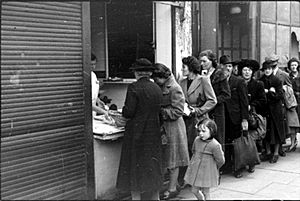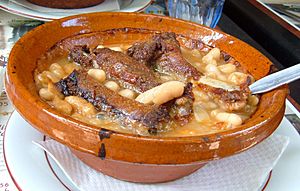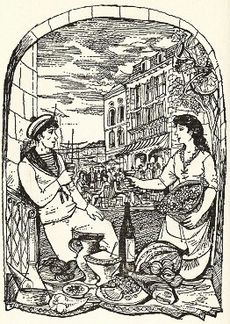A Book of Mediterranean Food facts for kids

Front cover of the first edition
|
|
| Author | Elizabeth David |
|---|---|
| Illustrator | John Minton |
| Country | England |
| Subject | Mediterranean cooking |
| Genre | Cookery |
| Publisher | John Lehmann |
|
Publication date
|
1950 |
A Book of Mediterranean Food is a very important cookery book written by Elizabeth David in 1950. It was her first book and was published by John Lehmann. After years of rationing (when food was limited) and tough times after World War II, this book brought new ideas and exciting flavors to English cooking.
Elizabeth David shared simple recipes using fresh ingredients. These ideas came from her time living in France, Italy, and Greece, where she learned about Mediterranean cooking. The book was illustrated by John Minton. Each chapter started with quotes from famous writers. Even though many ingredients were hard to find back then, the book quickly became popular. In just a few years, it completely changed how people in England cooked and ate.
Contents
Life After Wartime Rationing

After World War II, England still had strict food rationing. This meant people could only buy small amounts of certain foods. Elizabeth David had spent years living in sunny Mediterranean countries. There, she enjoyed lots of fresh ingredients.
When she returned to England, she found life very dull and the food quite bad. She described meals like "flour and water soup" and "bread and gristle rissoles." She really missed the delicious, fresh food she had enjoyed abroad.
How the Book Was Created
Elizabeth David started writing articles about Mediterranean cooking. She did this partly to earn money and partly because she missed the warm, sunny places she had lived. Her first articles appeared in a magazine called Harper's Bazaar in 1949.
She made sure to keep the rights to her articles. This way, she could gather them all and turn them into a book. She put her articles together and sent them to many publishers. However, they all said no. One publisher told her that a collection of recipes needed more connecting text.
Adding Famous Quotes
Elizabeth David took the advice to add more text. She knew she was new to writing books. So, she kept her own writing short. Instead, she used many quotes from well-known authors. These writers had shared their thoughts on the Mediterranean region.
With this selection...of Mediterranean dishes, I hope to give some idea of the lovely cookery of those regions to people who do not already know them, and to stir the memories of those who have eaten this food on its native shores, and who would like sometimes to bring a flavour of those blessed lands of sun and sea and olive trees into their English kitchens.
She sent her updated book to John Lehmann, a publisher known more for poetry than cookbooks. He accepted it and gave her an advance payment. A Book of Mediterranean Food was published in 1950. Lehmann had even suggested calling it "The Blue Train Cookery Book." He thought the idea of exciting train journeys to Mediterranean countries sounded romantic.
The book came out when food rationing was still very strict in Britain. Elizabeth David later said that "almost every essential ingredient of good cooking was either rationed or unobtainable." So, she changed some of her recipes. She found ways to make up for the lack of flavor from things like meat, stock, or butter.
The Book's Impact
Food historian Panikos Panayi believes that A Book of Mediterranean Food completely changed English cooking. He calls the book's opening words "perhaps the most evocative and inspirational passage in the history of British cookery writing."
David wrote about the cooking of the Mediterranean shores. She said it was full of natural resources, color, and flavor. She described it as a mix of old traditions and brilliant new ideas. She also mentioned the "Latin genius" that shines from the kitchen pans.
She then described the region and its wonderful smells:
From Gibraltar to the Bosphorous, down the Rhone Valley, through the great seaports of Marseilles, Barcelona, and Genoa ... stretches the influence of Mediterranean cooking, conditioned naturally by variations in climate and soil and the relative industry or indolence of the inhabitants. The ever recurring themes in the food throughout these countries are the oil, the saffron, the garlic, the pungent local wines...
Artistic Illustrations
John Lehmann asked his friend, the artist John Minton, to create the book's illustrations. Minton made a colorful cover and black and white drawings for inside the book. Many writers felt Minton's drawings made the book even more appealing.
Minton created 15 drawings that showed the feeling of the Mediterranean. They weren't just simple pictures of dishes. For example, one drawing shows a port scene with a sailor, a young woman, and food on a table. In the background, you can see a street restaurant and boats in a harbor. Elizabeth David didn't like Minton's black and white drawings very much. However, she loved his cover design, calling it "stunning." She especially liked his "beautiful Mediterranean bay" and the way "pitchers and jugs and bottles of wine could be seen far down the street."
What's Inside the Book
The book is divided into chapters. Each chapter focuses on a different type of food. These include soups, egg dishes, fish, meat, main courses, poultry and game, vegetables, cold food and salads, sweets, jams, and sauces.
Variety of Recipes
The soup chapter shows the book's style. It has short, simple recipes, like one for haricot bean soup. But it also includes long, detailed ones, like a three-page recipe for Mediterranean fish soup. The egg and luncheon dish section also mixes quick recipes, like ratatouille aux oeufs, with longer discussions, such as a three-page guide to making omelettes.
Unlike many cookbook writers, Elizabeth David rarely gives exact amounts or cooking times. For example, for fresh tuna, she suggests:
cut it into thick slices like a salmon steak, and sauté it in oil or butter, adding, half-way through the cooking 2 or 3 tomatoes, chopped, a handful of cut parsley, and a small glass of wine, either red or white. Serve plainly cooked potatoes with it.
The meat section starts with recipes for veal. This was not common in English homes in 1950. David also includes recipes for kid (young goat) and boar. Mutton was more popular back then, and David gives four recipes for it. One recipe makes mutton taste like venison by marinating it for a long time and using strong sauces.

The "substantial dishes" chapter talks about and explains dishes like risotto and paella. It also covers polenta and spaghetti, which were less known in Britain then. The chapter also describes cassoulet, a hearty French dish. The next chapter, on poultry and game, has recipes for chicken and duck. It also includes recipes for partridge, quail, and pigeons.
The book's Mediterranean focus is clear in the vegetable section. There are five recipes for aubergine (eggplant) but only one potato dish (pommes Anna). Dishes from Greece and North Africa are included, along with French favorites like tomates provençales. Sometimes, a non-Mediterranean dish appears, like cèpes à la bordelaise (mushrooms fried in olive oil with parsley and garlic).
The cold food and salads chapter gives instructions for cold chicken dishes. It also includes traditional pâtés and terrines. Another non-Mediterranean recipe is jambon persillé de Bourgogne, an Easter dish from Burgundy. David also suggests hors d'oeuvres (small appetizers). These include Greek dishes like dolmádés and taramá, which were new to Britain. She also includes French recipes like sardines marinées à la niçoise.
In the sweets section, David notes that complicated desserts are often bought from bakeries in Mediterranean countries. The few recipes she gives are for simple, homemade sweets. These include torrijas (also called pain perdu) and cold orange soufflé. The jams, chutneys, and preserves section includes preserved melon, along with more common fruits like pears and plums.
The final chapter is about sauces. David includes classic sauces like béchamel, béarnaise, hollandaise, and mayonnaise. She advises stirring mayonnaise "steadily but not like a maniac." She also adds Turkish, Greek, Italian, and Egyptian sauces. Most of these are meant to go with Mediterranean fish dishes.
Book Editions
Since 1950, A Book of Mediterranean Food has been published in many different editions. It has also been translated into other languages, including Danish and Chinese.
- London: Lehmann, 1950 (1st ed.)
- Harmondsworth : Penguin, 1950 (paperback)
- London: Lehmann, 1951
- New York City: Horizon, 1952
- Harmondsworth, New York : Penguin, 1955
- Harmondsworth : Penguin, 1956
- London: Macdonald, 1958 (2nd ed.)
- London: Cookery Book Club, 1958
- Baltimore: Penguin, 1958
- Baltimore: Penguin, 1960
- Harmondsworth: Penguin, 1960
- Harmondsworth: Penguin, 1965
- Harmondsworth, Baltimore : Penguin, 1966
- London: Cookery Book Club, 1968
- Harmondsworth: Penguin, 1971
- Harmondsworth: Penguin, 1975
- Harmondsworth: Penguin, 1977
- Harmondsworth: Penguin, 1983
- Copenhagen: Hans Reitzel/Gyldendals Bogklub, 1984
- Harmondsworth: Penguin, 1987
- London: Dorling Kindersley, 1988 (illus., rev.)
- Sydney: Collins, 1988
- Harmondsworth: Penguin, 1989 (2nd ed.)
- Harmondsworth: Penguin, 1991 (new intro.)
- Harmondsworth: Penguin, 1998
- New York: New York Review Books, 2002
- China: 麥田出版 / Tai Bei Shi, 2006 (地中海風味料理 / Di zhong hai feng wei liao li, by 大衛 David, Elizabeth with Da Wei; Fang-tian Huang
- London: Folio Society, 2009 (intro. by Julian Barnes, colour illus. by Sophie MacCarthy)
Images for kids
See also
 In Spanish: A Book of Mediterranean Food para niños
In Spanish: A Book of Mediterranean Food para niños



